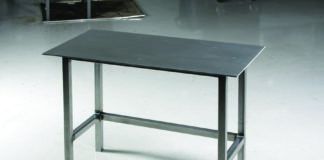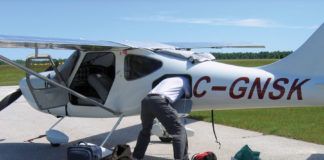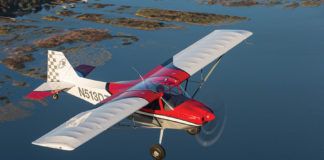Elsewhere in this issue, KITPLANES editors picked the Gear of the Year, a collection of new (and some not-so-new) stuff that gets them going, so to speak. For me, though, Oshkosh this year was an opportunity to sniff out and consider some of the larger trends.
Folding Wings
There were two planes at AirVenture this year with power folding wings, and neither was a homebuilt. One was the Terrafugia Transition (Its a roadable aircraft, not a flying car) and the other was the Icon A5 amphibian. Power folding wings are a potentially great advance beyond wings that require tools to do the job.
Personally, I love the idea of folding wings, but still, question the true practicality. When our Cessna was tied down outside, we could drive up to it, preflight it, and go. When our name cleared the hangar waiting list, the routine was open the hangar doors, preflight, drag the plane out, drive the car in, close the hangar doors. Time wise, this wasn’t really significant, but psychologically it was a barrier, and we got to go through the same routine putting the plane away. Power folding wings go a long way towards removing that psychological barrier to flight.
But still, if you trailer the plane to the airport for every flight, thats a barrier. And there are few places at most airports where folding wings will get you indoor parking thats not available to a plane with non-folding wings. The Vans RV-12 has removable wings-as have other designs-and the GlaStars have folding wings. I understand that not many GlaStar owners fold the wings with regularity. Id like folding wings to be hot, but they’re not, even with power folding.
Alternative Engines & Controls
Diesels for homebuilts have been on the horizon forever, but one of the cooler aircraft diesel engines was the WW-II Junkers Jumo diesel, which had top and bottom crankshafts, with pistons that came at each other in shared cylinders. A recent engine that uses this same configuration is the Gemini from Powerplant Developments. The engineers claim an sfc (brake specific fuel consumption) of 0.38, better than many aircraft gasoline engines, which at the very best score a 0.385 but are most often between 0.42 and 0.48. The Jumo/Gemini concept is hot, but its not on the shelf yet.
Electronic engine controls are finally here, big time. There have been electronic ignitions for years, and a few FADECs, but Lycoming has announced an Integrated Electronic Engine platform, with features such as integrated engine electrical power generation advanced sensor technology, and electronic knock detection. Fully automated engine management has been on the verge for a while, but todays fuel prices might just push it over into an economically feasible proposition. Hot.
Avionics
Anybody who has bought a computer recently knows that they become obsolete before they wear out-this scores a not hot for me-and avionics are changing almost as fast, with WAAS and synthetic vision becoming common.
There are cool possibilities in the com radio arena, though we haven’t seen much appear so far. The UPSAT, nee Garmin, SL 30 was perhaps the first GA com radio to use a digital signal processor-basically a really fast number-cruncher-to replace analog components in the com receiver. The bonus is that once the DSP is in there, if its fast enough, it can simultaneously listen to two or more channels. If the pilot commands, the SL 30 will provide audio from a second com channel when there is no signal on the primary channel. The pilot can build situational awareness by listening to ATIS while talking to approach or listening to the tower while taxiing out on ground. And a GPS database can provide frequencies for tuning both com and nav.
But there’s still more to be done. Were all supposed to monitor 121.5 these days, so how about having a dedicated 121.5 monitor channel, maybe with a light to annunciate signal on 121.5 so you don’t miss anything? And if you ever fly out of an airport in Class C airspace, you’ll want a second preset channel for storing departure control. That second preset would also come in handy for quickly getting ground control after landing at an airport with approach, tower and ground. This is all easy to do electronically, but the user interface can quickly get challenging-how do you promote one of several monitored channels to primary? This idea of com automation is hot, but the execution is not hot.
Think back to rapidly evolving avionics, tablet computers and such. How about a removable tablet computer that is used as your instrumentation system? At home, you could download data from the web, including fuel prices, and preview a flight in simulator mode, using synthetic vision. You could review engine performance history and even how precisely you flew the last few times. Take the unit out to the airplane, connect it to the ADAHRS and GPS, if those aren’t built in, maybe make a few more connections, and you would be good to go. The big challenge here will be to make the installation neat and seamless. This one could evolve to hot.
I like that many avionics vendors are considering electrical failure modes. All-electric airplanes need adequate backup, and some vendors such as Dynon have optional 2-hour battery backups for their instrumentation, which is hot. The 30-minute capability required by the FAA is inadequate, but the industrys response is hot.
GPS provides such high accuracy that it can increase the probability of collision on airways and published flight routes. Id like to see GPS navigators automatically use ground speed to calculate an offset-the faster you go, the farther you are off centerline, like maybe 250 knots takes you a mile off. This wouldn’t work on approach, but it would work for en route. Along the same lines, I can see us eventually flying track, not heading. Did you know that Light Sport Aircraft do not need a magnetic compass? They can do everything on GPS. And why not fly track? Forget about all the crab/variation/deviation stuff; let the GPS tell you your actual track. This could be hot.
Good User Interfaces
Having spent a few decades designing user interfaces for computers, workstations, PDAs and avionics, I don’t think that the current user interface Tower of Babel will ever be straightened out. Consumers, having been beaten silly by bad desktop computer user interfaces (think Windows), do not demand good ones. Vendors seldom have qualified user interface designers who are also qualified pilots. (A friend who works in user interfaces recently wrote that now that hes getting his instrument rating, workload is no longer an abstract concept.) And the testing of new designs is relatively quick and dirty, even at the really big shops. All of the above: not hot.
As if this werent enough, it is not totally clear that good solutions always exist. Its so much simpler to design a user interface for the semi-standardized world of IFR flying, but there are so many variations in the VFR and sport flying world that a system flexible enough to handle all of those situations will inevitably involve ugly compromises. And instead of working from fundamental use cases to meet specific needs, designers all too often just copy what everybody else is doing.
Bottom Line
The electronics revolution is really taking hold in the cockpit, but even way back when, the old-timers used to emphasize to me the importance of good stick and rudder skills. As a soon to be old-timer myself, I wonder how many desktop computer pilots will really grasp the significance and enjoy the satisfaction of mastery of the airframe and atmosphere. At least this compelling new technology comes with an Off button. Thats hot.
Ed Wischmeyer is an ATP/CFII with an MIT Ph.D. who has worked for an airframer and two avionics houses, taught graduate level courses in aviation safety, and developed user interfaces for desktop applications, PDAs and aircraft. In his 35 years of flying, hes accumulated 3000 hours in 150 makes and models.




